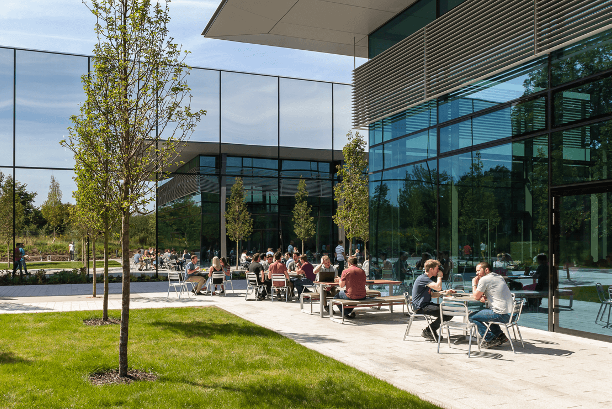Designing a Workplace that Reflects People and Brand
At Work Transformers, we often find that the most effective workplaces are the ones that reflect both the people who use them and the brand they represent. One of our projects demonstrated this perfectly: how a strong workplace strategy can transform employee experience, support productivity, and create an environment that employees are proud of.
The Challenge
Our client had ambitious goals for its workplace. The existing environment was functional but not inspiring. The feedback we heard was clear:
- Breakout spaces were highly valued, but they were small, underperforming, and not aligned with how people wanted to use them.
- Technology was outdated, slowing down meetings and collaboration.
- Collaboration spaces were limited in type and scale, pushing staff into inappropriate areas like atriums for ad-hoc conversations.
- Concentration was difficult to achieve in an open-plan setting that offered little privacy.
- Look and feel didn’t reflect the innovative, design-led nature of the brand. Employees wanted a workplace they could be proud of – a space that not only functioned well but also showcased the company to clients and partners.
Our Approach
We began with a comprehensive engagement programme to understand how the business operated and how people worked day-to-day. This included:
- Observation studies to capture how space was used in real time.
- Staff surveys and interviews to collect perspectives across functions and roles.
- Building plan analysis to evaluate space allocations and identify gaps.
- Workshops with employees to validate findings and co-create future options.
This evidence-driven approach gave us a balanced picture of demand (what the business needed from its workplace) and supply (what the existing space was providing).
Key Insights
Six strong themes emerged:
- Breakout Space – Staff valued informal and social areas but found existing provision too limited. They needed places to relax, meet, and catch up outside the desk environment.
- Look & Feel – The current environment did not reflect the creativity and identity of the organisation. A more stimulating, brand-aligned workspace was essential.
- Collaboration – A lack of variety in meeting and collaborative spaces meant that effective teamwork was compromised. Ad-hoc and small group meetings were common but poorly supported.
- Technology – Meeting room equipment and digital tools underperformed, wasting time and frustrating staff. Reliable, intuitive technology was critical.
- Concentration – While collaboration was important, the ability to work quietly and without interruption was equally vital. Staff needed choice – not just open-plan desks.
- Location – Accessibility and amenities at the site were considered strong, reinforcing its role as a hub for collaboration and knowledge sharing.
From Insight to Strategy
To respond to these findings, we developed a holistic workplace strategy that addressed both people and place:
- Workstyles Defined – Employees were grouped into four profiles: residents, concentrators, collaborators, and mobiles. Each had different workspace needs, from high desk presence to high mobility.
- Menu of Settings – A varied set of environments was proposed, ranging from open-plan desks and touchdown spots to quiet rooms, project spaces, and informal collaboration areas. This gave people choice, ensuring every workstyle was supported.
- Layered Zoning – Future floorplate models introduced zones for focus, collaboration, and social interaction, carefully balanced to reduce distraction and improve flow.
- Technology Integration – Recommendations included upgrades to meeting room equipment, simplified booking systems, and better tools for cross-site collaboration.
- Brand & Culture – The new workplace was designed to feel like a showcase, embodying the values of innovation and quality that staff identified with.
The Outcome
The final strategy created a workplace blueprint that:
- Gave employees more choice in how and where they worked.
- Balanced spaces for concentration with those for teamwork.
- Expanded and improved breakout and social areas to foster community.
- Delivered a stronger brand identity through design, making the workplace an environment staff could be proud of.
- Improved technology to make meetings more seamless and collaboration more effective.
Why It Matters
This project highlights the power of aligning workplace strategy with both human needs and organisational identity. It shows that a workplace is never just about desks and meeting rooms – it is about how people feel, how effectively they can work, and how the organisation presents itself to the outside world.
By rethinking the balance between concentration, collaboration, and culture, the workplace becomes more than a place to work – it becomes a destination that inspires.




